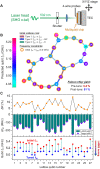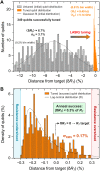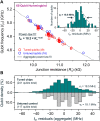High-performance superconducting quantum processors via laser annealing of transmon qubits
- PMID: 35559683
- PMCID: PMC9106287
- DOI: 10.1126/sciadv.abi6690
High-performance superconducting quantum processors via laser annealing of transmon qubits
Abstract
Scaling the number of qubits while maintaining high-fidelity quantum gates remains a key challenge for quantum computing. Presently, superconducting quantum processors with >50 qubits are actively available. For these systems, fixed-frequency transmons are attractive because of their long coherence and noise immunity. However, scaling fixed-frequency architectures proves challenging because of precise relative frequency requirements. Here, we use laser annealing to selectively tune transmon qubits into desired frequency patterns. Statistics over hundreds of annealed qubits demonstrate an empirical tuning precision of 18.5 MHz, with no measurable impact on qubit coherence. We quantify gate error statistics on a tuned 65-qubit processor, with median two-qubit gate fidelity of 98.7%. Baseline tuning statistics yield a frequency-equivalent resistance precision of 4.7 MHz, sufficient for high-yield scaling beyond 103 qubit levels. Moving forward, we anticipate selective laser annealing to play a central role in scaling fixed-frequency architectures.
Figures





References
-
- Ladd T. D., Jelezko F., Laflamme R., Nakamura Y., Monroe C., O’Brien J. L., Quantum computers. Nature 464, 45–53 (2010). - PubMed
-
- Preskill J., Quantum computing in the NISQ era and beyond. Quantum 2, 79 (2018).
-
- Gambetta J. M., Chow J. M., Steffen M., Building logical qubits in a superconducting quantum computing system. NPJ Quantum Inf. 3, 2 (2017).
-
- Barends R., Kelly J., Megrant A., Veitia A., Sank D., Jeffrey E., White T. C., Mutus J., Fowler A. G., Campbell B., Chen Y., Chen Z., Chiaro B., Dunsworth A., Neill C., O’Malley P., Roushan P., Vainsencher A., Wenner J., Korotkov A. N., Cleland A. N., Martinis J. M., Superconducting quantum circuits at the surface code threshold for fault tolerance. Nature 508, 500–503 (2014). - PubMed
-
- Jurcevic P., Javadi-Abhari A., Bishop L. S., Lauer I., Bogorin D. F., Brink M., Capelluto L., Gunluk O., Itoko T., Kanazawa N., Kandala A., Keefe G. A., Krsulich K., Landers W., Lewandowski E. P., McClure D. T., Nannicini G., Narasgond A., Nayfeh H. M., Pritchett E., Rothwell M. B., Srinivasan S., Sundaresan N., Wang C., Wei K. X., Wood C. J., Yau J.-B., Zhang E. J., Dial O. E., Chow J. M., Gambetta J. M., Demonstration of quantum volume 64 on a superconducting quantum computing system. Quantum Sci. Technol. 6, 025020 (2021).
LinkOut - more resources
Full Text Sources
Other Literature Sources

